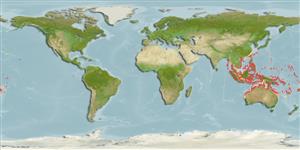Common names from other countries
Environment: milieu / climate zone / depth range / distribution range
Ecologia
Associadas(os) a recifes; intervalo de profundidade 0 - 30 m (Ref. 348). Tropical; 23°C - 30°C (Ref. 102835); 29°N - 28°S, 91°E - 170°W
Indo-West Pacific.
Length at first maturity / Tamanho / Peso / Idade
Maturity: Lm ?, range 13 - 15 cm Max length : 50.0 cm SHL macho/indeterminado; (Ref. 117184); common length : 20.0 cm SHL macho/indeterminado; (Ref. 348)
The valves are thick, heavy and triangular in shape, often covered with reddish spots and obscured by encrustations. The mantle is a deep yellowgreen, irregularly mottled at the periphery and in the center.
Collected for food and shell, the latter commonly used in the shellcraft industry (Ref. 348). Maximum depth from Ref. 75831. In relatively shallow water, in lagoon, barrier and fringing reefs (Ref. 106851). Found in intertidal areas on corals (Ref. 75831). Tridacnids derive their nutrition from uptake of dissolved matter through their epidermis and from their symbiotic zooanthella Symbiodinium microadriaticum (Ref. 107098).
Life cycle and mating behavior
Maturidade | Reprodução | Desova | Ovos | Fecundidade | Larvas
Broadcast spawners. Life cycle: Embryos develop into free-swimming trocophore larvae, succeeded by the bivalve veliger, resembling a miniature clam (Ref. 833).
Poutiers, J.M. 1998. (Ref. 348)
Status na Lista Vermelha da IUCN (Ref. 130435)
Status no CITES (Ref. 108899)
Not Evaluated
Perigo para os humanos
Harmless
Uso pelos humanos
Pescarias: espécies comerciais; Aquacultura: espécies comerciais
| FishSource | Sea Around Us
Ferramentas
Fontes da internet
Estimates based on models
Preferred temperature
(Ref.
115969): 25.6 - 29.3, mean 28.7 (based on 2485 cells).
Resiliência
Baixo, tempo mínimo de duplicação da população 4,5 - 14 anos (K=0.12-0.2; tm=4).
Vulnerabilidade
Moderate to high vulnerability (50 of 100).
Categoria de preço
Unknown.
